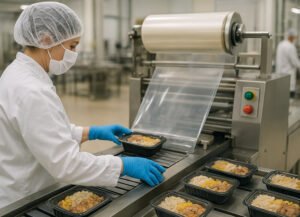What Are the Machines Used for Food Packaging?
Table of Contents
Introduction
In today’s fast-paced food industry, efficient and hygienic packaging is essential for maintaining product quality, extending shelf life, and meeting consumer demands. A Food Packaging Machine plays a crucial role in automating the packaging process, ensuring consistency, speed, and compliance with food safety standards. From small-scale operations to large manufacturing facilities, various types of packaging machinery are employed to handle different food products and packaging requirements. This article explores the diverse range of machines used in food packaging and their specific functions in the production line.
Filling Machines
Filling machines are fundamental components of any food packaging operation. These machines accurately dispense precise quantities of food products into containers, bottles, pouches, or cans. Different types of filling machines cater to various food consistencies. Liquid filling machines are ideal for beverages, sauces, and oils, while powder filling machines handle dry ingredients like flour, spices, and protein powders. For products with chunks or particulates, such as soups or fruit preserves, piston fillers provide the necessary capability. The accuracy and speed of a Food Packaging Machine in the filling category directly impact production efficiency and product consistency.
Sealing Machines
Once food products are filled into their containers, sealing machines ensure that packages are properly closed to maintain freshness and prevent contamination. Heat sealers use controlled temperature to bond plastic films or foils together, creating airtight seals for bags and pouches. Induction sealers employ electromagnetic induction to hermetically seal containers with foil liners, commonly used for bottles and jars. Capping machines automatically apply and tighten caps on bottles and jars at high speeds. The reliability of sealing equipment is critical for preserving food quality and meeting regulatory requirements for tamper-evident packaging.
Wrapping and Shrink Wrap Machines
Wrapping machines provide protective layers around food products, enhancing both preservation and presentation. Flow wrappers, also known as horizontal form-fill-seal machines, create sealed packages around individual items like candy bars, baked goods, or cheese blocks. Shrink wrap machines encase products in plastic film that shrinks tightly when heated, creating a secure, transparent package perfect for multipacks or irregular-shaped items. Stretch wrappers apply elastic film around palletized goods, stabilizing loads for transportation. These machines not only protect food from environmental factors but also provide attractive retail presentation.
Labeling Machines
Labeling machines apply product information, branding, and regulatory details to food packages. Pressure-sensitive labelers apply pre-printed adhesive labels to containers, while sleeve labelers wrap shrinkable sleeves around bottles and cans for 360-degree graphics. Print-and-apply systems generate labels on-demand with variable information like batch codes, expiration dates, and barcodes. In modern food production, a sophisticated Food Packaging Machine with integrated labeling capabilities ensures compliance with food labeling regulations while maintaining brand consistency across product lines.
Vacuum Packaging Machines
Vacuum packaging machines remove air from packages before sealing, significantly extending the shelf life of perishable foods. Chamber vacuum sealers place the entire package inside a chamber where air is evacuated before sealing, ideal for liquids and delicate items. External vacuum sealers draw air through the open end of specially designed bags, suitable for solid foods. Thermoforming vacuum machines create custom-shaped packages from film, fill them with product, and seal them under vacuum—commonly used for meats, cheeses, and prepared meals. By removing oxygen, these machines inhibit bacterial growth and preserve food quality.
Cartoning and Boxing Machines
Cartoning machines automate the process of forming cartons, inserting products, and closing boxes. Horizontal cartoners load products horizontally into end-load cartons, typical for pouches, bottles, or wrapped items. Vertical cartoners drop products from above into top-load cartons, suitable for cereals, pasta, or snack foods. Case packers arrange multiple units into shipping cases, while case erectors automatically form flat cardboard blanks into boxes. These machines dramatically increase packaging throughput while reducing manual labor and ensuring consistent package appearance.

Form-Fill-Seal Machines
Form-fill-seal (FFS) machines represent highly integrated packaging solutions that create packages from roll stock film, fill them with product, and seal them in a continuous operation. Vertical form-fill-seal (VFFS) machines form bags vertically, commonly used for snacks, frozen foods, and granular products. Horizontal form-fill-seal (HFFS) machines create packages horizontally, ideal for solid items and products requiring precise positioning. This type of Food Packaging Machine offers exceptional efficiency by combining multiple packaging steps into one automated system, reducing material handling and minimizing contamination risks.
Conveyor and Sorting Systems
While not packaging machines per se, conveyor systems and sorting equipment are essential components of integrated packaging lines. Belt conveyors transport products between different packaging stations, while accumulation conveyors create buffers to balance line speeds. Sorting systems use vision technology or mechanical means to orient products correctly before packaging. Check weighers verify package weights to ensure compliance with regulations, and metal detectors identify contamination. These auxiliary systems ensure smooth material flow and quality control throughout the packaging process.
Conclusion
The modern food packaging industry relies on a diverse array of specialized machinery to meet the demands of safety, efficiency, and consumer appeal. From filling and sealing to wrapping and labeling, each type of Food Packaging Machine serves a specific purpose in the packaging line. As technology advances, these machines continue to evolve with improved automation, enhanced hygiene features, and greater flexibility to handle multiple product types. Investing in the right combination of packaging equipment enables food manufacturers to optimize production, reduce waste, ensure product quality, and remain competitive in an increasingly demanding marketplace. Understanding the capabilities and applications of different packaging machines is essential for anyone involved in food production and distribution.
Ready to Upgrade Your Food Packaging Line?
Discover the perfect Food Packaging Machine solutions tailored to your production needs. Whether you’re looking to increase efficiency, improve product quality, or expand your packaging capabilities, we’re here to help.
Contact our packaging experts today for a free consultation!
Transform your packaging operations with cutting-edge technology and expert support.
